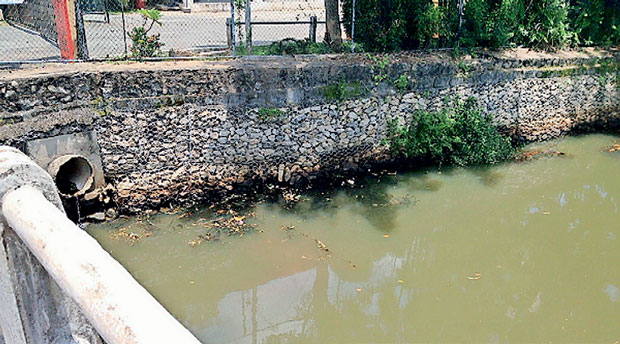22 Mar 2017 - {{hitsCtrl.values.hits}}

 This year’s theme of the World Water Day focuses on waste water. This article highlights the urgent need for effective management of waste water, given the severity of the problem and the catastrophic outcomes it could result in if not handled wisely.
This year’s theme of the World Water Day focuses on waste water. This article highlights the urgent need for effective management of waste water, given the severity of the problem and the catastrophic outcomes it could result in if not handled wisely.
Water can easily become ‘waste water’ due to many reasons – mostly tied to human activity. The most common sources of waste water include domestic effluent consisting ‘black water’ (excreta, urine and faecal sludge) and ‘grey water’ (kitchen and bathing waste water), effluents from commercial establishments (e.g., restaurants and hotels) and other working places including hospitals, storm water and urban run-off and effluent from industrial, agricultural, horticultural and aquaculture sources.
Effluents from industrial and agricultural sources and from hospitals are considered water pollution; comprehensive pollution control measures that go beyond mere disposal of waste water are necessary to handle the problem of water pollution. On the other hand, managing waste water from domestic and commercial sources and urban run-off is largely a matter of proper disposal.
However, given the scale and frequency of waste water generated from these sources, especially in urban areas, where population and economic activities are concentrated, ‘proper disposal’ requires comprehensive solutions based on scientific management. This article focuses on domestic, commercial and urban run-off waste water, which has received limited attention by many.
Waste water is an uncomfortable and unpleasant subject that many prefer to avoid. However, it cannot be easily ignored as everyone is faced with the problem of waste water on a daily basis, whether at home, workplace or during the everyday commute. Developed countries have invested large amounts of resources to manage waste water, giving it high priority and treating the issue as a matter of social welfare.
In fact, the level of priority and resources allocated for solving the issue of waste water reflect a fundamental difference in attitudes towards social welfare between developed and developing societies. In many developing countries, even educated and wealthy members of society seem to be intent on turning a blind eye to the harsh reality and prefer to stay in their own comfort zones, rather than actively seeking solutions to the issue.
The usual inclination is to dispose the waste from one’s own premises without giving much thought to the health and environmental repercussions of their actions. In this sense, the waste water problem is remarkably similar to the garbage problem. Some people carry domestic garbage bags in vehicles and covertly dump them at isolated places. The same motive is visible when a suburban household surreptitiously empties its waste water pits to storm water drains during heavy showers. Such behaviour is motivated by the lack of public collection and sanitary disposal systems, a situation prevalent in many developing countries.
Common methods for disposal of waste water
There are two basic waste water management strategies. They are onsite (non-sewered) disposal and off-site (sewered) disposal with or without centralized treatment facilities. In urban areas, off-site disposal of waste water and disposal of surface run-off are closely connected. Therefore, in some countries, combined systems that convey run-off water with foul sewage in the same pipes can be found. However, many countries have resorted to systems that carry surface run-off and foul sewage separately.
Off-site disposal systems are more effective and are in place worldwide. Modern cities in developed countries have established extensive systems for waste water collection and disposal with centralized treatment facilities. Like other public infrastructure facilities such as transport, urban parks, water and electricity supply, these waste water management facilities also play a major role in making these cities more habitable, contributing to high living standards enjoyed by citizens.
However, establishing such off-site disposal facilities are costly operations. They need high capital investments for establishment and large operational budgets for running and maintenance. Users are charged for these services by utility companies that operate on volumetric basis. Large utility companies are usually run as public-private partnerships under close supervision of city administrations.
In developing countries, city administrators have limited means to invest in modern waste water management systems and low-income city dwellers cannot be expected to bear the full cost of services they offer. As a result, many developing countries are unable to afford such systems. Hence, modern waste water treatment facilities are restricted to limited areas of large urban centres in the developing world. When available, these systems are usually located in service opulent neighbourhoods and a large majority of the population suffers due to lack of proper waste water disposal facilities.
These underprivileged areas are usually left with onsite disposal systems in various forms of operational arrangements. Usually such systems are less hygienic and chaotic situations arise during disasters such as urban floods. Furthermore, poor storm water and drainage systems and ill-designed onsite disposal facilities themselves contribute to hazardous events such as flash floods very often.
Waste water management in Sri Lanka
The current waste water management systems in place in Sri Lanka are abysmal. Being a developing country, Sri Lanka is also plagued with inefficiencies in waste water management mentioned above. Sewer connections are only available for restricted areas in the Colombo city and for a few other major cities. Inherited from the colonial period, some sections of these systems are dilapidated and are in dire need of renovations and upgrades.
Extension work on the pipe system is moving at a snail’s pace and the existing systems do not have centralized treatment facilities. Waste water collected from the Colombo sewerage system is dumped into the sea in two locations. Many other fast-developing coastal towns follow this lead, making them leading contributors to marine pollution.
Beyond the limited area covered by pipe connected facilities, the outskirts of city areas and surrounding suburbs mostly have to depend on on-site waste water disposal methods. The common practices include individual facilities of septic tanks or open-bottom soakage pits for black water and open bottom waste water pits for grey water. However, very often, grey water is channelled illegally to storm water drains directly or indirectly.
In underserved areas of Colombo and other cities, residents often have no choice but to share common toilet pits and dispose kitchen and bath water to storm water drains, creating uninhabitable conditions in the surrounding environments. Coupled with ill-designed storm water drains and run-off water disposal facilities, non-standard waste water disposal methods are the reason that Colombo and other major cities in the island are plunged into chaos during flash floods.
Overall, poor investment on standard public waste water disposal facilities has led many residents in urban areas to depend on individual on-site waste water disposal facilities. The quality of these facilities varies greatly. Moreover, this causes accumulation of waste water in large quantities in local neighbourhoods, affecting the groundwater.
In some suburban areas, residents are still dependent on shallow groundwater wells for domestic water supply and they get affected from groundwater polluted by accumulated waste water. Considering this situation, some technical standards have been imposed in building approval criteria regarding locating septic tanks and waste water pits when constructing houses. However, the effectiveness of such measures, monitoring of those standards and level of compliance cannot be guaranteed.
Waste water challenge
Sri Lanka boasts of the prevalence of sanitation facilities even among poorer communities, when compared with many other developing countries. However, the management of waste water is an exception and remains a challenge. It is a public health and environmental hazard that cannot be left for residents to resolve on their own. Serious health and environmental issues demand public solutions where individuals have to play their roles considering their own and community welfare.
Individuals cannot make large public investments required for establishing standard facilities and the government and city administrations need to give due priority to initiate such facilities. However, effective systems need resources for establishment of facilities and efficient operation that cannot be borne by cash-strapped city administrations alone. Beneficiaries of the facilities also have to bear some burden here. This requires innovations in technical as well as management and institutional aspects of waste water management solutions in the country.
(Athula Senaratne is a Research Fellow at the Institute of Policy Studies of Sri Lanka (IPS). To view this article online and to share your comments, visit the IPS Blog ‘Talking Economics’ – http://www.ips.lk/talkingeconomics/)
09 Jan 2025 1 hours ago
09 Jan 2025 2 hours ago
09 Jan 2025 2 hours ago
09 Jan 2025 2 hours ago
09 Jan 2025 2 hours ago